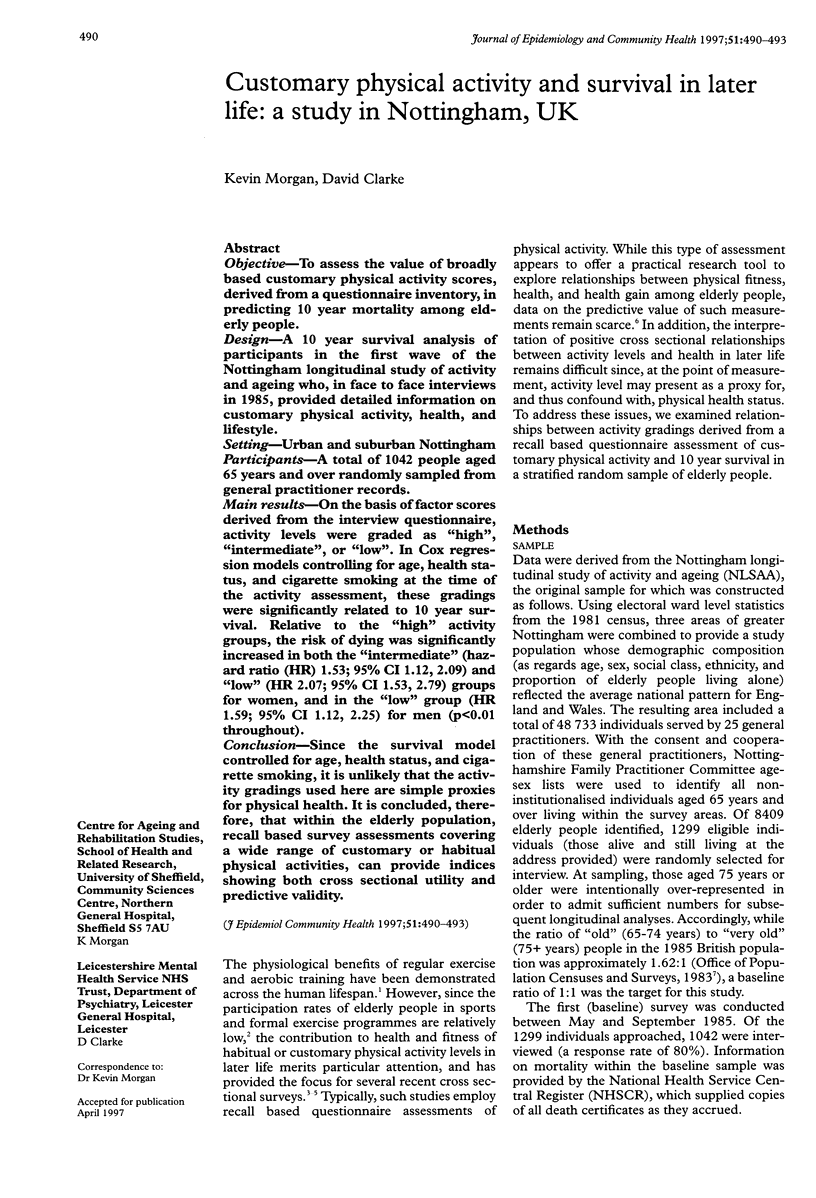Abstract
OBJECTIVE: To assess the value of broadly based customary physical activity scores, derived from a questionnaire inventory, in predicting 10 year mortality among elderly people. DESIGN: A 10 year survival analysis of participants in the first wave of the Nottingham longitudinal study of activity and ageing who, in face to face interviews in 1985, provided detailed information on customary physical activity, health, and lifestyle. SETTING: Urban and suburban Nottingham PARTICIPANTS: A total of 1042 people aged 65 years and over randomly sampled from general practitioner records. MAIN RESULTS: On the basis of factor scores derived from the interview questionnaire, activity levels were graded as "high", "intermediate", or "low". In Cox regression models controlling for age, health status, and cigarette smoking at the time of the activity assessment, these gradings were significantly related to 10 year survival. Relative to the "high" activity groups, the risk of dying was significantly increased in both the "intermediate" (hazard ratio (HR) 1.53; 95% CI 1.12, 2.09) and "low" (HR 2.07; 95% CI 1.53, 2.79) groups for women, and in the "low" group (HR 1.59; 95% CI 1.12, 2.25) for men (p < 0.01 throughout). CONCLUSION: Since the survival model controlled for age, health status, and cigarette smoking, it is unlikely that the activity gradings used here are simple proxies for physical health. It is concluded, therefore, that within the elderly population, recall based survey assessments covering a wide range of customary or habitual physical activities, can provide indices showing both cross sectional utility and predictive validity.
Full text
PDF



Selected References
These references are in PubMed. This may not be the complete list of references from this article.
- Bassey E. J., Morgan K., Dallosso H. M., Ebrahim S. B. Flexibility of the shoulder joint measured as range of abduction in a large representative sample of men and women over 65 years of age. Eur J Appl Physiol Occup Physiol. 1989;58(4):353–360. doi: 10.1007/BF00643509. [DOI] [PubMed] [Google Scholar]
- Dallosso H. M., Morgan K., Bassey E. J., Ebrahim S. B., Fentem P. H., Arie T. H. Levels of customary physical activity among the old and the very old living at home. J Epidemiol Community Health. 1988 Jun;42(2):121–127. doi: 10.1136/jech.42.2.121. [DOI] [PMC free article] [PubMed] [Google Scholar]
- LaCroix A. Z., Leveille S. G., Hecht J. A., Grothaus L. C., Wagner E. H. Does walking decrease the risk of cardiovascular disease hospitalizations and death in older adults? J Am Geriatr Soc. 1996 Feb;44(2):113–120. doi: 10.1111/j.1532-5415.1996.tb02425.x. [DOI] [PubMed] [Google Scholar]
- Ruuskanen J. M., Ruoppila I. Physical activity and psychological well-being among people aged 65 to 84 years. Age Ageing. 1995 Jul;24(4):292–296. doi: 10.1093/ageing/24.4.292. [DOI] [PubMed] [Google Scholar]
- Smith G. D., Morris J. N. Assessment of physical activity, and physical fitness, in population surveys. J Epidemiol Community Health. 1992 Apr;46(2):89–91. doi: 10.1136/jech.46.2.89. [DOI] [PMC free article] [PubMed] [Google Scholar]


